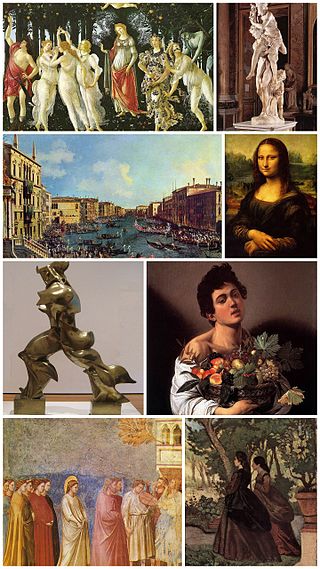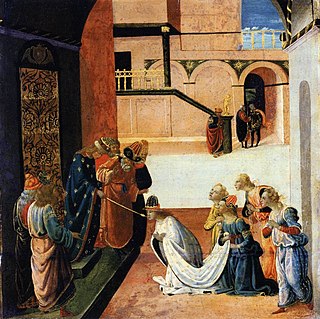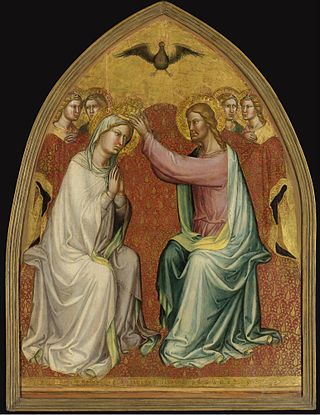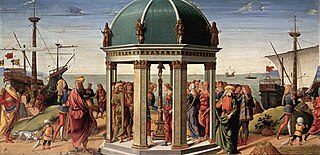
The Sienese School of painting flourished in Siena, Italy, between the 13th and 15th centuries. Its most important artists include Duccio, whose work shows Byzantine influence, his pupil Simone Martini, the brothers Pietro and Ambrogio Lorenzetti and Domenico and Taddeo di Bartolo, Sassetta, and Matteo di Giovanni.

The cultural and artistic events of Italy during the period 1400 to 1499 are collectively referred to as the Quattrocento from the Italian word for the number 400, in turn from millequattrocento, which is Italian for the year 1400. The Quattrocento encompasses the artistic styles of the late Middle Ages, the early Renaissance, and the start of the High Renaissance, generally asserted to begin between 1495 and 1500.

The Gallerie dell'Accademia is a museum gallery of pre-19th-century art in Venice, northern Italy. It is housed in the Scuola della Carità on the south bank of the Grand Canal, within the sestiere of Dorsoduro. It was originally the gallery of the Accademia di Belle Arti di Venezia, the art academy of Venice, from which it became independent in 1879, and for which the Ponte dell'Accademia and the Accademia boat landing station for the vaporetto water bus are named. The two institutions remained in the same building until 2004, when the art school moved to the Ospedale degli Incurabili.

Philbrook Museum of Art is an art museum with expansive formal gardens located in Tulsa, Oklahoma. The museum, which opened in 1939, is located in a former 1920s villa, "Villa Philbrook", the home of Oklahoma oil pioneer Waite Phillips and his wife Genevieve. Showcasing nine collections of art from all over the world, and spanning various artistic media and styles, the cornerstone collection focuses on Native American art featuring basketry, pottery, paintings and jewelry.
The School of Ferrara was a group of painters which flourished in the Duchy of Ferrara during the Renaissance. Ferrara was ruled by the Este family, well known for its patronage of the arts. Patronage was extended with the ascent of Ercole d'Este I in 1470, and the family continued in power till Alfonso II, Ercole's great-grandson, died without an heir in 1597. The duchy was then occupied in succession by Papal and Austrian forces. The school evolved styles of painting that appeared to blend influences from Mantua, Venice, Lombardy, Bologna, and Florence.

The Columbia Museum of Art is an art museum in the American city of Columbia, South Carolina.

Matteo di Giovanni was an Italian Renaissance artist from the Sienese School.

Jacopo del Sellaio (1441/42–1493), was an Italian painter of the early Renaissance, active in his native Florence. His real name was Jacopo di Arcangelo. He worked in an eclectic style based on those of Botticelli, Filippino Lippi, and Domenico Ghirlandaio. The nickname Sellaio derives from the profession of his father, a saddle maker.

The Lives of the Most Excellent Painters, Sculptors, and Architects, often simply known as The Lives, is a series of artist biographies written by 16th-century Italian painter and architect Giorgio Vasari, which is considered "perhaps the most famous, and even today the most-read work of the older literature of art", "some of the Italian Renaissance's most influential writing on art", and "the first important book on art history".

Martino di Bartolomeo or Martino di Bartolomeo di Biago was an Italian painter and manuscript illuminator active between 1389 and 1434. He was one of his generation's principal painters of the Sienese School. From specific aspects of his early style, he is believed to have trained in the studio of Taddeo di Bartolo. As a young man Martino collaborated with Giovanni di Pietro da Napoli in Pisa. The fresco cycle in the church of San Giovanni Battista di Cascina, outside Pisa, bears Martino’s signature, and the date 1398. He returned permanently to Siena in 1405; there he painted several prominent fresco cycles in the Duomo and the Palazzo Pubblico. Further official commissions for altarpieces and for polychromy of sculptures attest to his versatility and to his prestige as one of the city’s official artists.

Manuel Gregorio Acosta (1921–1989) was a Mexican-born American painter, muralist, sculptor, and illustrator. His work received more recognition during the Chicano movement, and his portrait of Cesar Chavez was reproduced on the cover of Time magazine in 1969.

Biagio d’Antonio Tucci was an Italian Renaissance painter active in Florence, Faenza and Rome.

The Rollins Museum of Art is located on the Winter Park campus of Rollins College and is the only teaching museum in the greater Orlando area. The museum houses more than 5,000 objects ranging from antiquity through contemporary eras, including rare old master paintings and a comprehensive collection of prints, drawings, and photographs. The museum displays temporary exhibitions on a rotating basis along with the permanent collection.

The Musée du Petit Palais is a museum and art gallery in Avignon, southern France. It opened in 1976 and has an exceptional collection of Renaissance paintings of the Avignon school as well as from Italy, which reunites many "primitives" from the collection of Giampietro Campana. It is housed in a 14th-century building at the north side of the square overlooked by the Palais des Papes. The building, built in the early 14th century as the residence of the bishops of Avignon, was made a UNESCO World Heritage Site as part of the historic center of Avignon in 1995.

Lowe Art Museum is the art museum of the University of Miami in Coral Gables, Florida. The museum is located on the campus of the University of Miami and is accessible by Miami Metrorail at University Station.
Louis Alexander Waldman is an American art historian and author specializing in the Italian Renaissance.

The University of Arizona Museum of Art (UAMA) is an art museum in Tucson, Arizona, operated by the University of Arizona. The museum's permanent collection includes more than 6,000 works of art, including paintings, sculptures, prints and drawings with an emphasis on European and American fine art from the Renaissance to the present.

The musée Fesch is the central museum of fine arts in Ajaccio on Corsica. Located within the gated Palais Fesch, it is in the town's Borgu d'Ajaccio quarter. It was established by Napoleon I's uncle, cardinal Joseph Fesch, in Fesch's birthplace.

The Pinacoteca del Castello Sforzesco is an art gallery in the museum complex of the Castello Sforzesco in Milan, northern Italy.



















